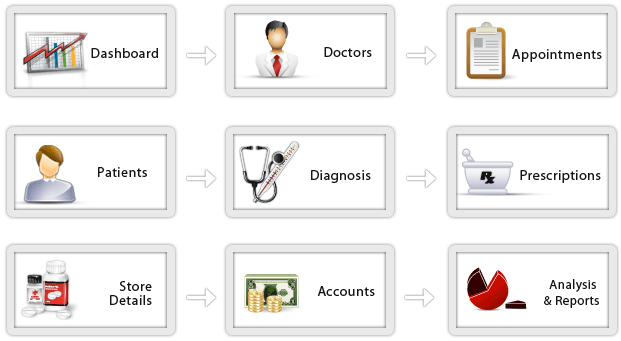Hospital Information Management System (HIMS): Revolutionising Healthcare Administration

In the ever-evolving landscape of healthcare, Hospital Information Management Systems (HIMS) have emerged as a critical tool in the efficient administration of healthcare facilities. This article explores the significance, features, benefits, challenges, and the impact of HIMS on healthcare institutions, patient care, and administrative processes.
1. Introduction
Efficient administration is the backbone of every healthcare institution. Hospital Information Management Systems (HIMS) have transformed healthcare administration by digitising and streamlining processes, ultimately improving patient care.
2. Understanding Hospital Information Management Systems (HIMS)
2.1 What Is a Hospital Information Management System?
A Hospital Information Management System (HIMS) is a comprehensive, integrated software solution designed to manage and streamline various administrative and clinical tasks within a healthcare facility. It encompasses functions such as patient registration, appointment scheduling, billing, and electronic health records (EHR) management.
2.2 Key Features of HIMS
Patient Records Management: Stores and manages patient health records, including medical history, treatment plans, and test results.
Appointment Scheduling: Facilitates efficient scheduling of patient appointments.
Billing and Revenue Management: Handles billing, insurance claims, and financial transactions.
Inventory Management: Manages medical supplies and equipment inventory.
Analytics and Reporting: Provides data analytics tools for insights into operational performance.
3. The Importance of Hospital Information Management Systems
HIMS plays a pivotal role in modern healthcare for several reasons:
Streamlined Administration: It simplifies and automates administrative processes, reducing paperwork and manual tasks.
Enhanced Patient Care: It allows healthcare providers to access and update patient records quickly, leading to better-informed decisions and improved patient care.
Data Accessibility: It ensures that critical healthcare information is readily available when needed.
Data Security: It employs robust security measures to protect patient information and maintain compliance with privacy regulations.
Cost Savings: It can lead to cost savings by optimising resource allocation and reducing administrative overhead.
4. Benefits of Hospital Information Management Systems
4.1 Streamlined Administrative Processes
HIMS significantly reduces administrative burdens by automating processes such as appointment scheduling, billing, and inventory management.
4.2 Enhanced Patient Care
With comprehensive patient records accessible in real-time, healthcare providers can deliver more personalised and efficient care.
4.3 Data Accessibility and Security
HIMS ensures that patient data is readily accessible to authorised personnel while maintaining strict data security and privacy measures.
4.4 Improved Decision-Making
Data analytics tools in HIMS provide insights into operational performance, enabling better decision-making for healthcare administrators.
4.5 Cost Savings
By optimising resource allocation and reducing paperwork, HIMS can lead to cost savings for healthcare institutions.
5. Challenges in Implementing Hospital Information Management Systems
5.1 Initial Costs and Training
The implementation of HIMS may involve initial setup costs and staff training, which can be a substantial investment.
5.2 Data Migration and Integration
Migrating existing paper records to digital formats and integrating HIMS with other healthcare systems can be complex.
5.3 User Resistance
Healthcare professionals accustomed to traditional methods may resist the transition to digital systems.
6. Customization and Interoperability
Healthcare institutions should consider whether the chosen HIMS can be customised to fit their specific needs and whether it can seamlessly integrate with other healthcare systems.
7. Choosing the Right Hospital Information Management System
Selecting the appropriate HIMS involves assessing factors such as scalability, customization options, support, and compliance with healthcare regulations.
8. Future Trends in Hospital Information Management Systems
Future developments in HIMS include enhanced interoperability, telehealth integration, artificial intelligence for predictive analytics, and increased patient engagement through mobile applications.
9. Conclusion
Hospital Information Management Systems (HIMS) have become indispensable tools in modern healthcare administration, significantly improving efficiency, patient care, and overall operational performance. As technology continues to advance, healthcare institutions embracing HIMS are poised to deliver higher-quality care while optimising their administrative processes.
10. Frequently Asked Questions (FAQs)
Q1: What are the primary advantages of Hospital Information Management Systems (HIMS)?
HIMS offers benefits such as streamlined administrative processes, enhanced patient care, data accessibility and security, improved decision-making, and cost savings.
Q2: How does HIMS enhance data security?
HIMS employs robust security measures to protect patient information, including encryption, access controls, and compliance with privacy regulations.
Q3: Can HIMS integrate with other healthcare systems?
Yes, interoperability is a key feature of HIMS, allowing it to seamlessly integrate with other healthcare systems and share data.
Q4: What role does HIMS play in telehealth?
HIMS can facilitate telehealth services by providing access to patient records and enabling remote consultations.
Q5: How can healthcare institutions overcome user resistance to adopting HIMS?
Effective training, change management strategies, and highlighting the benefits of HIMS can help overcome user resistance and facilitate smooth adoption.